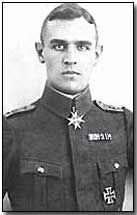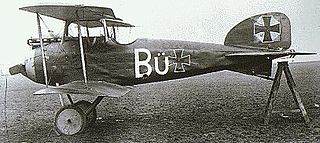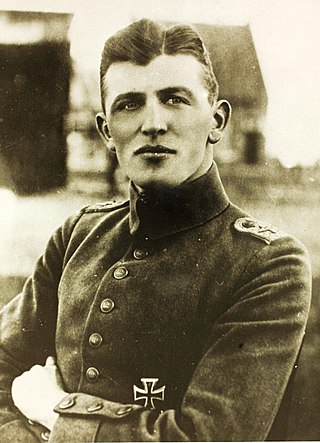Carl "Charly" DegelowPour le Merite, Royal House Order of Hohenzollern, Iron Cross, was a German fighter pilot during World War I. He was credited with 30 victories, and was the last person to win the military Pour le Merite.

The Pfalz D.III was a fighter aircraft used by the Luftstreitkräfte during the First World War. The D.III was the first major original design from Pfalz Flugzeugwerke. Though generally considered inferior to contemporary Albatros and Fokker fighters, the D.III was widely used by the Jagdstaffeln from late 1917 to mid-1918. It continued to serve as a training aircraft until the end of the war.

Franz Büchner PlM was one of the most successful German fighter aces of the First World War, shooting down 40 enemy aircraft. He began his military career as a 16-year-old infantryman. His doughty exploits earned him a battlefield commission just after his 18th birthday, in early 1916. After being wounded and invalided from the infantry, he joined the Imperial German Air Service. Once he progressed to become a fighter pilot flying a Fokker D.VII, he initially struggled to gain his first aerial victories. Something clicked after his fifth victory, and he began to regularly shoot down enemy airplanes, scoring 35 victories between 1 July and 22 October 1918. Most notably, he shot down four SPADs on 26 September. He survived the war, but died in action in 1920 while combating communist revolutionaries near Leipzig.

Theodor "Theo" Osterkamp was a German fighter pilot during World War I and World War II. A flying ace, he achieved 32 victories in World War I. In World War II, he led Jagdgeschwader 51 up to the Battle of Britain and claimed a further six victories during World War II, in the process becoming one of only a few men to score victories and become an ace in both world wars.

Rittmeister Carl Bolle, PlM, MMC, HOH, IC, was a fighter ace with 36 aerial victories during World War I. He became a Jagdstaffel commander during that war, and an advisor to the Luftwaffe during World War II.

Jasta 2 was one of the best-known German Luftstreitkräfte Squadrons in World War I. Its first commanding officer was the great aerial tactician Oswald Boelcke, and it was the incubator of several notable aviation careers.

OberleutnantHenrich Claudius Kroll Pour le Merite, Knight's Cross of the Royal House Order of Hohenzollern, Saxony's Albert Order Knight Second Class with Swords, Iron Cross First and Second Class, was a World War I fighter ace credited with 33 victories.
Generalmajor Hermann Frommherz Military Order of St. Henry, Royal House Order of Hohenzollern, Knight's Cross of the Military Karl-Friedrich Merit Order, began his military career in World War I as a German ace fighter pilot. He was credited with 32 victories. During World War II he was involved in the German takeover of Czechoslovakia and rose to become a Luftwaffe Generalmajor.
Paul Billik was a German World War I fighter ace credited with 31 victories. He was killed in a flying accident while pioneering civil aviation.

Adolf Ritter von Tutschek (16 May 1891 – 15 March 1918) PlM, MOMJ was a professional soldier turned aviator. As German air strategy turned towards concentrated air power, he was entrusted with one of the world's first fighter wings.

OberleutnantFriedrich Ritter von Röth was a German World War I fighter ace with 28 victories. He was the most successful German pilot at the extremely hazardous practice of shooting down enemy observation balloons, and destroyed 20 of them. Röth concentrated on observation balloons because they were large enough targets for him to see and hit with machine gun fire.

Hans Kirschstein, winner of the Pour le Merite, Royal House Order of Hohenzollern, and the Iron Cross, 1st and 2nd class, was a German lieutenant and World War I flying ace credited with 27 aerial victories.
Leutnant Fritz Höhn was a German World War I fighter ace credited with 21 victories. He had worked his way up to being a fighter squadron commander and was eligible for the German Empire's highest award for heroism, the Blue Max, when he was killed in action on 3 October 1918.
Leutnant Ludwig Hanstein HOH, Bavaria's MMO was a World War I flying ace credited with 16 aerial victories.
Colonel Alois Heldmann was a World War I flying ace credited with 15 confirmed aerial victories while he was a Leutnant. He later joined the nascent Luftwaffe in 1933 and was a flying school inspector until the end of World War II.
Hans-Georg von der Marwitz was a German World War I flying ace credited with 15 aerial victories.
LeutnantPaul Strähle was a German World War I flying ace credited with 15 aerial victories.

Royal Prussian Jagdstaffel 12 was a World War I "hunting group" of the Luftstreitkräfte, the air arm of the Imperial German Army during World War I. As one of the original German fighter squadrons, the unit would score 155 aerial victories during the war, at the expense of seventeen killed in action, eight wounded in action, and one taken prisoner of war.
General-major Hans-Eberhardt Gandert was a German professional soldier who began his 33-year military career in 1912. He learned to fly in the early days of World War I, went on to become a flying ace credited with eight aerial victories, including killing British ace Edwin Benbow, and ended the war in command of a fighter group. In the wake of Germany's defeat, he would serve in the German Army until 1934. He would then transfer into the newly established Luftwaffe and serve in increasingly responsible posts until mid-World War II. He retired on 28 February 1945.
Jagdgeschwader III was a fighter wing of the Imperial German Air Service during World War I. It was founded on 2 February 1918, as a permanent consolidation of four established jagdstaffeln —2, 26, 27, and 36. JG III was formed as a follow-on of Manfred von Richthofen's highly successful Jagdgeschwader I. With a nominal strength of 56 aircraft, JG III would be under direct orders of an Armee headquarters. The German General Staff was planning a German spring offensive to begin on 21 March 1918, and wanted to assign a fighter wing to each of the three Armees involved in the assault. An experienced flying ace with 22 victories, Oberleutnant Bruno Loerzer, was appointed to command JG III.









